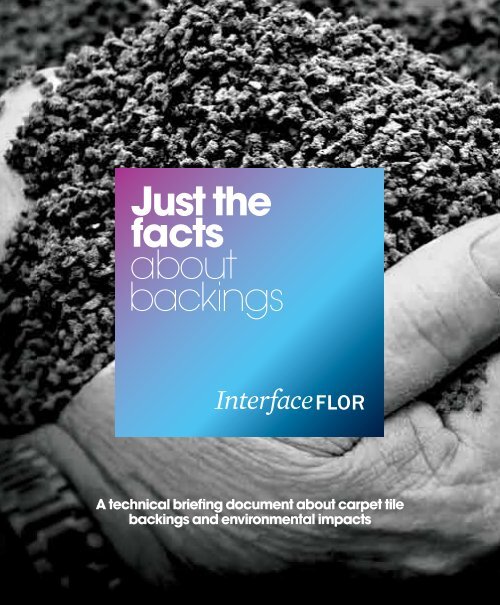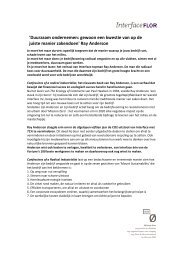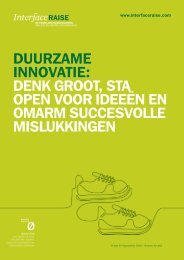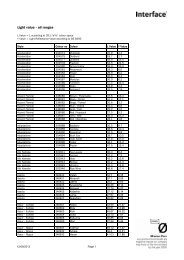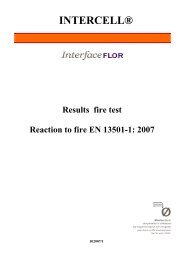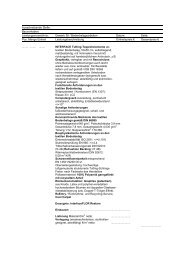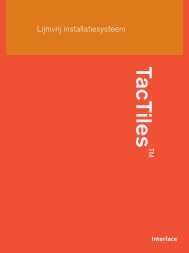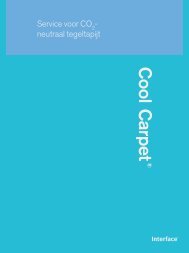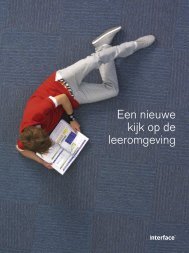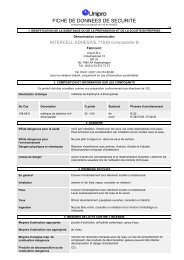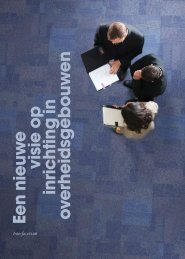of carpet tile backings - Interface
of carpet tile backings - Interface
of carpet tile backings - Interface
You also want an ePaper? Increase the reach of your titles
YUMPU automatically turns print PDFs into web optimized ePapers that Google loves.
1<br />
A technical briefing document about <strong>carpet</strong> <strong>tile</strong><br />
<strong>backings</strong> and environmental impacts
2<br />
Just the facts about <strong>backings</strong>
3<br />
Contents<br />
04<br />
06<br />
08<br />
10<br />
12<br />
16<br />
18<br />
20<br />
24
4<br />
Just the facts about <strong>backings</strong><br />
Environmental impacts<br />
in a <strong>carpet</strong> <strong>tile</strong>’s life cycle<br />
LCA <strong>of</strong> a <strong>carpet</strong> <strong>tile</strong><br />
68%<br />
45% Yarn<br />
Yarn has 4 times more<br />
impact than the backing<br />
11% Backing compound<br />
6% Glass fleece and turfing carrier<br />
4% Precoat bonding layer<br />
1% Packaging/1% Raw materials<br />
9%<br />
8% 8% 7%<br />
The calculations are based on a 700g<br />
<strong>carpet</strong> <strong>tile</strong> made with PA6.6 and<br />
<strong>Interface</strong>FLOR’s Graphlex ® backing with<br />
the following assumptions: landfilling at<br />
end-<strong>of</strong>-life, no green energy use in the<br />
life-cycle, and a product lifetime (use)<br />
<strong>of</strong> 10 years.<br />
Raw materials<br />
Manufacturing<br />
Transportation<br />
Customer use<br />
End <strong>of</strong> life
5<br />
An objective description<br />
<strong>of</strong> product sustainability<br />
requires an understanding <strong>of</strong><br />
the life cycle <strong>of</strong> the product.<br />
A Life Cycle Assessment (LCA)<br />
studies the environmental<br />
impacts throughout the life<br />
<strong>of</strong> a product: from extraction<br />
to production <strong>of</strong> raw<br />
materials, through to our own<br />
manufacturing and transport,<br />
and use, maintenance and<br />
disposal by our customers.<br />
<strong>Interface</strong>FLOR conducts<br />
a full LCA for every <strong>carpet</strong><br />
<strong>tile</strong> we launch. We follow<br />
the methodology agreed<br />
at industry level by GUT – a<br />
<strong>carpet</strong> industry association<br />
established to ensure<br />
environmentally compatible<br />
production, compliance with<br />
strict test criteria on hazardous<br />
substances and minimal<br />
emissions and odours in<br />
new <strong>carpet</strong>s.<br />
More than two thirds <strong>of</strong> the<br />
environmental impact <strong>of</strong><br />
a <strong>carpet</strong> <strong>tile</strong> relates to the<br />
raw materials needed for<br />
manufacture. Nylon yarn has<br />
the single biggest impact<br />
because its production is very<br />
energy intensive as a result <strong>of</strong><br />
the chemical reactions involved<br />
in transforming crude-oil into<br />
the molecular precursor <strong>of</strong><br />
nylon. It accounts for almost<br />
half <strong>of</strong> the total environmental<br />
impact <strong>of</strong> a <strong>carpet</strong> <strong>tile</strong> –<br />
around four times more than<br />
the backing compound, for<br />
example.
6<br />
Just the facts about <strong>backings</strong><br />
Using LCA to reduce<br />
environmental impact
7<br />
Targeting reductions <strong>of</strong> the<br />
biggest environmental impacts<br />
on our products is a priority. One<br />
way in which this is done is by<br />
exploring ways to reduce the<br />
total amount <strong>of</strong> nylon used or to<br />
use recycled yarn<br />
However, our aim is to reduce all<br />
the environmental impacts <strong>of</strong> all<br />
our products to zero. This means<br />
cutting the impacts <strong>of</strong> every<br />
component at every stage <strong>of</strong> the<br />
life cycle <strong>of</strong> our products.<br />
The challenge is to reduce the<br />
overall environmental impact<br />
<strong>of</strong> our products (not just <strong>of</strong><br />
particular components) and<br />
processes (throughout the<br />
whole supply chain) without<br />
compromising on performance<br />
and quality. If a particular part<br />
<strong>of</strong> the product does not perform<br />
well, it could decrease the life<br />
expectancy <strong>of</strong> the whole <strong>carpet</strong>,<br />
requiring it to be replaced more<br />
frequently and significantly<br />
increase the overall impact.
8<br />
Just the facts about <strong>backings</strong><br />
Why is <strong>carpet</strong> <strong>tile</strong><br />
backing important?<br />
High quality backing is<br />
essential to the performance<br />
and durability <strong>of</strong> the product.<br />
It enables heavy wear without<br />
deterioration. Characteristics<br />
<strong>of</strong> a good backing include:<br />
• Flatness and stability –<br />
preventing <strong>tile</strong>s from moving,<br />
curling up or creating gaps over<br />
time<br />
• Dimensional stability –<br />
assuring <strong>tile</strong>s do not shrink or<br />
expand under varied conditions<br />
<strong>of</strong> humidity and temperature<br />
• Floor hugging capability –<br />
minimising or eliminating the<br />
need for adhesives
9<br />
• Improved insulation and<br />
sound absorption<br />
• Low flammability and good<br />
smoke ratings<br />
• Low emissions <strong>of</strong> vola<strong>tile</strong><br />
organic compounds (VOCs)<br />
and other substances that can<br />
degrade indoor air quality<br />
• Recycled content and potential<br />
to recycle at end<br />
<strong>of</strong> life<br />
• Compatibility with cleaning<br />
techniques such as hot water<br />
extraction, which can extend<br />
the life <strong>of</strong> the <strong>carpet</strong> by<br />
removing stains.
10<br />
Just the facts about <strong>backings</strong><br />
Understanding product<br />
environmental performance<br />
Different manufacturers<br />
use different <strong>carpet</strong> <strong>tile</strong><br />
backing compounds<br />
based on characteristics<br />
such as performance and<br />
cost to produce. Each type<br />
<strong>of</strong> backing also has<br />
different environmental<br />
impacts, which must be<br />
considered. Here, we<br />
describe the types <strong>of</strong><br />
backing systems for<br />
<strong>carpet</strong> <strong>tile</strong>s available<br />
on the market today and<br />
outline their respective<br />
environmental impacts.
11<br />
Bitumen-based<br />
backing systems<br />
(e.g. <strong>Interface</strong>FLOR’s<br />
Graphlex ® backing)<br />
The most common type <strong>of</strong><br />
backing in Europe is made <strong>of</strong> a<br />
mix <strong>of</strong> polymermodified bitumen<br />
(PMB) with varying amounts <strong>of</strong><br />
limestone filler. Bitumen is a<br />
complex hydrocarbon obtained<br />
from the processing <strong>of</strong> crude oil.<br />
It can be modified with polymers<br />
to improve the backing’s<br />
technical performance – and<br />
extend the life <strong>of</strong> the product<br />
– by increasing resilience and<br />
dimensional stability. However,<br />
the chemical processes to<br />
make the polymers used in the<br />
backing also use energy.<br />
The polymer-modified bitumen<br />
compound is mixed with<br />
limestone filler to give the <strong>tile</strong><br />
weight and stability. This filler<br />
accounts for up to 70% <strong>of</strong> the<br />
total weight <strong>of</strong> the backing.<br />
Limestone is an abundant<br />
material which has a very low<br />
environmental impact, and<br />
the high filler content helps to<br />
improve the backing’s overall<br />
LCA figures as well as making<br />
it economical to produce.<br />
<strong>Interface</strong>FLOR’s Graphlex ®<br />
bitumen-based backing systems<br />
also have low VOC emissions<br />
(which can affect indoor air<br />
quality and health) and enable<br />
superior floor hugging and<br />
loose-lay capabilities.
12<br />
Just the facts about <strong>backings</strong><br />
Types <strong>of</strong> <strong>carpet</strong><br />
<strong>tile</strong> <strong>backings</strong><br />
PVC-based backing systems<br />
(e.g. <strong>Interface</strong>FLOR’s<br />
GlasBac ® backing)<br />
PVC (Polyvinyl Chloride)<br />
is a material made from<br />
ethylene (processed from<br />
petrochemicals) and chlorine,<br />
which is extracted from rock<br />
salt or seawater.PVC provides<br />
superior dimensional stability,<br />
durability and non-corroding<br />
and flameretardant properties.<br />
Mixing it with different amounts<br />
and types <strong>of</strong> plasticizers adds<br />
s<strong>of</strong>tness and flexibility to suit<br />
different uses. As with bitumenbased<br />
<strong>backings</strong>, PVC is mixed<br />
with limestone filler for stability<br />
and weight. For <strong>Interface</strong>FLOR<br />
products, PVC represents<br />
a small component <strong>of</strong> our<br />
GlasBac ® backing, less than<br />
15% <strong>of</strong> our backing composite<br />
by weight. There have been two<br />
concerns with PVC.<br />
The first concern with PVC<br />
relates to certain harmful<br />
plasticizers. The most common
13<br />
plasticizers are <strong>of</strong> a chemical<br />
type known as phthalates.<br />
Some <strong>of</strong> these have been found<br />
to be ‘endocrine disruptors’ in<br />
animal testing. In our GlasBac ®<br />
backing we phased out DEHP<br />
(diethylhexyl phthalate) in 2001.<br />
The plasticizer used currently is<br />
di-isononyl phthalate (DINP),<br />
accounting for less than 17%<br />
<strong>of</strong> total weight. DINP has not<br />
been found to pose any risk on<br />
human health in an extensive<br />
life cycle study conducted by the<br />
European Union in 2006. This<br />
study also found no risk to the<br />
atmosphere, aquatic ecosystem<br />
or terrestrial ecosystem from<br />
such use <strong>of</strong> DINP.<br />
The second concern is the use<br />
<strong>of</strong> heavy metal stabilisers. If<br />
ingested, heavy metals can<br />
accumulate in the body and<br />
cause disease. We have not<br />
used any heavy metals in our<br />
GlasBac ® backing since 1996<br />
when we phased out barium/zinc<br />
heat stabilisers.
14<br />
Just the facts about <strong>backings</strong><br />
Types <strong>of</strong> <strong>carpet</strong><br />
<strong>tile</strong> <strong>backings</strong><br />
Polyurethane-based<br />
<strong>backings</strong><br />
Polyurethane is a polymer<br />
material that can take different<br />
forms – liquid, solid or foam. It<br />
is resilient, flexible and durable.<br />
Polyurethane foam has been<br />
used for many years as a<br />
backing alternative, particularly<br />
in the speciality or comfort<br />
backing sector, as it provides<br />
extra cushion as well as sound<br />
insulation and absorption.<br />
We currently recommend our<br />
ReCushion Bac ® , a 100%<br />
polyurethane foam backing<br />
option to customers who want<br />
particular comfort or acoustic<br />
performance. <strong>Interface</strong>FLOR<br />
uses polyurethane foam that<br />
contains 85% post-industrial<br />
recycled polyurethane, which<br />
reduces energy use significantly<br />
compared to virgin material.<br />
However, its chemical structure<br />
makes it very difficult to recycle<br />
the backing at end <strong>of</strong> life.<br />
Polyolefin-based<br />
backing systems<br />
Polyolefin is a type <strong>of</strong> polymer<br />
used independently or in<br />
combination with other<br />
copolymers. Generally olefinbased<br />
systems are very energyintensive.<br />
Unlike PVC, polyolefin<br />
compounds do not require the<br />
use <strong>of</strong> plasticizers. This type<br />
<strong>of</strong> backing is quite new to the<br />
market and accounts for a very<br />
small proportion <strong>of</strong> the sales<br />
in Europe. At <strong>Interface</strong>FLOR,<br />
we <strong>of</strong>fered a polyolefin backing<br />
option in the 1980’s and have<br />
since further explored the<br />
use <strong>of</strong> polyolefin as a backing<br />
material but concluded that in<br />
our view, Graphlex ® backing is<br />
still the best option.
15<br />
PES tex<strong>tile</strong> <strong>backings</strong><br />
Polyester (PES) is a category<br />
<strong>of</strong> polymers that includes<br />
polyethylene terephthalate<br />
(PET). PET is easy to<br />
recycle and processes for<br />
manufacturing from recycled<br />
PET are well developed<br />
and economically viable.<br />
This makes it possible to<br />
produce PET products almost<br />
in a closed loop (through<br />
the recycling <strong>of</strong> used PET<br />
materials). Several <strong>carpet</strong> <strong>tile</strong><br />
manufacturers in Europe have<br />
introduced <strong>backings</strong> made <strong>of</strong><br />
nonwoven polyester fibres in<br />
recent years. The nonwoven<br />
layer is bonded to the<br />
tufted <strong>carpet</strong> either through<br />
a coat <strong>of</strong> bitumenbased<br />
compound or another polymer,<br />
which increases costs and<br />
environmental impact.<br />
PES tex<strong>tile</strong> <strong>backings</strong> generally<br />
have a less solid structure<br />
compared to the other types<br />
<strong>of</strong> <strong>backings</strong> and they are lightweight,<br />
which can be a benefit<br />
to carry and transport. However,<br />
a current downside is the<br />
need for more glue than other<br />
types <strong>of</strong> <strong>backings</strong> to keep the<br />
<strong>carpet</strong> <strong>tile</strong>s effectively in place,<br />
affecting VOCs to the indoor air<br />
adversely.
16<br />
Just the facts about <strong>backings</strong><br />
Recycling: Closing the<br />
loop on backing<br />
Replacing virgin materials<br />
with recycled content in<br />
our products wherever<br />
possible, can significantly<br />
reduce their environmental<br />
impact. At the same time<br />
we aim to make it easier<br />
to recycle them, to prevent<br />
them going to landfill and<br />
to enable them to be<br />
recycled into new <strong>carpet</strong><br />
<strong>tile</strong>s. We call this closing<br />
the loop.
17<br />
Using recycled content<br />
<strong>Interface</strong>FLOR already makes<br />
<strong>carpet</strong> <strong>tile</strong>s out <strong>of</strong> waste<br />
materials – from our own or<br />
other industries. In 2011,<br />
44% <strong>of</strong> our total raw materials<br />
globally were recycled or biobased<br />
materials. For example,<br />
the limestone we use as a<br />
filler in our backing is ground<br />
down into very small particles.<br />
This means we can make use<br />
<strong>of</strong> the waste limestone dust<br />
from quarries or road laying<br />
that other industries cannot<br />
use. Furthermore, we have<br />
introduced Cool Green in the<br />
UK, a line that converts <strong>carpet</strong><br />
scraps and small amounts <strong>of</strong><br />
old <strong>carpet</strong> into backing for new<br />
<strong>tile</strong>s. Our Graphlex ® <strong>backings</strong><br />
in Europe currently contain<br />
an average <strong>of</strong> 58% recycled<br />
content by weight and our aim is<br />
to have 100%.<br />
‘Like for like’ recycling<br />
‘Recyclable’ is one <strong>of</strong> the<br />
most misused environmental<br />
terms. People use it to describe<br />
many things, such as ‘reuse’,<br />
‘like for like’, ‘downcycling’<br />
and ‘incineration’. The fact<br />
is that almost anything can<br />
be recyclable but it is not<br />
always economically or<br />
environmentally feasible to do<br />
so. What would be the point,<br />
for example, <strong>of</strong> recycling a<br />
diamond or a mobile phone<br />
into cement? True recycling<br />
means separating all product<br />
components and transforming<br />
them into something <strong>of</strong> similar<br />
value. We do that with <strong>carpet</strong><br />
<strong>tile</strong>s – recycling yarn to yarn<br />
and backing to backing. In<br />
North America, our GlasBac ® RE<br />
backing is 100% recycled,<br />
including 51% post-consumer<br />
recycled content from reclaimed<br />
<strong>carpet</strong>.<br />
In Europe, our ReEntry 2.0<br />
enables clean and effective<br />
separation <strong>of</strong> the main<br />
components – yarn and<br />
backing – and leaves only<br />
a small fraction for energy<br />
recovery currently while we<br />
are investigating alternative<br />
recycling outlets. This ensures<br />
that the materials retain their<br />
value and can be re-used<br />
as new raw material for new<br />
products. The backing materials<br />
reclaimed through ReEntry 2.0<br />
can be fed straight into the<br />
manufacturing process for new<br />
<strong>carpet</strong> backing on site.<br />
And what’s more important, the<br />
processes allow us to recycle<br />
also the yarn, which has more<br />
embodied impact.
18<br />
Just the facts about <strong>backings</strong><br />
Less impact or higher<br />
recyclability?<br />
Other key questions are:<br />
Will the material actually<br />
be recycled? And will the<br />
gains <strong>of</strong> avoiding virgin<br />
materials compensate for<br />
the impacts created in the<br />
recycling process?<br />
The ideal design process<br />
considers the following:<br />
• Uses materials with low<br />
impact in the first place<br />
• Uses materials with a high<br />
degree <strong>of</strong> recyclability into the<br />
same materials<br />
• Designs the whole product<br />
so that each material can be<br />
easily separated<br />
• Designs the product and<br />
process where separation <strong>of</strong><br />
materials can be done using a<br />
minimum <strong>of</strong> energy<br />
• Optimises impacts for the full<br />
product life cycle, not just part<br />
<strong>of</strong> it.<br />
However, in the real world,<br />
compromises are <strong>of</strong>ten needed.<br />
A typical case would be using<br />
a backing with higher impact<br />
that could be beneficial later<br />
because <strong>of</strong> high recyclability.<br />
That might be a clever choice<br />
if you assume 100% <strong>of</strong> the<br />
products will be returned from<br />
customers for recycling. But<br />
reality is not perfect and the rate<br />
<strong>of</strong> return will be less. So the key<br />
to deciding on this compromise<br />
<strong>of</strong> higher impact with lower<br />
recyclability relies on having the<br />
right assumption for the return<br />
rate. Being over-optimistic could<br />
create more impact.<br />
<strong>Interface</strong>FLOR is working<br />
hard not to make this type <strong>of</strong><br />
compromise in the future by<br />
researching new materials and<br />
recycling methods that can<br />
use both materials with lower<br />
embodied impact and a high<br />
degree <strong>of</strong> recyclability.
20<br />
Just the facts about <strong>backings</strong><br />
Cutting VOC emissions to<br />
improve indoor air quality<br />
Emissions <strong>of</strong> vola<strong>tile</strong> organic<br />
compounds (VOCs) affect<br />
the indoor air quality <strong>of</strong><br />
buildings and can be toxic at<br />
high concentrations. Carpet<br />
generally has significantly lower<br />
VOC emissions than other<br />
building materials such as<br />
paints, adhesives or laminate<br />
flooring. VOC emissions from<br />
all <strong>Interface</strong>FLOR products are<br />
below the strict limits set by<br />
GUT and significantly lower than<br />
the limits set by various national<br />
environmental regulators<br />
measured after 3 days or 28<br />
days <strong>of</strong> production, as shown in<br />
the table opposite.<br />
References:<br />
German regulation for VOCs:<br />
www.umweltbundesamt.de/<br />
bauprodukte/agbb.htm<br />
French regulation for VOCs:<br />
www.afsset.fr/<br />
GEV EMICODE:<br />
http://www.emicode.de<br />
Blue Angel:<br />
http://www.blauer-engel.de<br />
GUT standard:<br />
http://www.pro-dis.info<br />
TVOC limits from various standards and regulations<br />
Standard<br />
µg / m³ after 3 days<br />
µg / m³ after 28 days<br />
German regulation<br />
(AgBB, building products)<br />
French regulation<br />
(AFSSET, for building productions)<br />
GEV EMICODE EC1<br />
(for adhesives)<br />
Blue Angel RAL UZ 113<br />
(for adhesives)<br />
GUT (for <strong>carpet</strong>, standard<br />
used by <strong>Interface</strong>FLOR)<br />
10000<br />
5000<br />
1000<br />
1000<br />
250<br />
1000<br />
200<br />
100<br />
100<br />
100
21<br />
Adhesives used to install<br />
<strong>carpet</strong> <strong>tile</strong>s <strong>of</strong>ten emit much<br />
higher levels <strong>of</strong> VOCs than the<br />
<strong>carpet</strong> itself. This means that<br />
comparing VOC emissions from<br />
different types <strong>of</strong> <strong>carpet</strong> <strong>tile</strong>s is<br />
meaningless without including<br />
those from the adhesive. The<br />
most effective way to cut VOCs<br />
is to eliminate the need for glue<br />
altogether.<br />
The limit value for TVOCs<br />
for adhesives with “very low<br />
emissions” according to<br />
Emicode EC1 (and Blue Angel)<br />
is 1000 μg/m³ after 3 days<br />
or 100 μg/m³ after 28 days.<br />
For a <strong>carpet</strong> <strong>tile</strong> the limit value<br />
is 250 μg/m³ after 3 days<br />
or 100 μg/m³ after 28 days.<br />
Generally emissions from new<br />
materials decrease sharply in<br />
the first weeks and follow an<br />
exponential curve as shown in<br />
the comparison opposite.<br />
Typical emission decay curves for<br />
adhesive and <strong>carpet</strong> thresholds<br />
EC1 – “very low emissions” adhesive<br />
GUT – standard for <strong>carpet</strong><br />
1400<br />
1200<br />
TVOCs µg/m³<br />
1000<br />
800<br />
600<br />
400<br />
200<br />
Adhesive<br />
Carpet<br />
TacTiles*<br />
00<br />
01 02 03 04 05 06 07 08 09 10 11 12 13 14 15 16 17 18 19 20 21 22 23 24 25 26 27 28<br />
Days<br />
*(TacTiles emissions tests performed by TNO)
22<br />
Just the facts about <strong>backings</strong><br />
Cutting VOC emissions to<br />
improve indoor air quality<br />
Installation without glue<br />
Glue is used in conventional<br />
installation to keep the <strong>tile</strong>s<br />
in place and prevent gaps<br />
or upcurling during use.<br />
<strong>Interface</strong>FLOR has developed<br />
TacTiles , a revolutionary<br />
gluefree system to install <strong>carpet</strong><br />
<strong>tile</strong>s, which cuts environmental<br />
impacts drastically compared<br />
to traditional glue and virtually<br />
eliminates VOCs.<br />
TacTiles are placed in the<br />
corners <strong>of</strong> the <strong>tile</strong>s to connect<br />
them to each other and create<br />
a floating floor. This makes<br />
replacement and uplifting <strong>of</strong><br />
individual <strong>tile</strong>s much easier,<br />
and recycling at end <strong>of</strong> life<br />
less complicated, as the glue<br />
is not stuck to the backing.<br />
Installation waste from the<br />
packaging <strong>of</strong> the glue itself is<br />
also eliminated. TacTiles can<br />
be used with our Graphlex ® or<br />
GlasBac ® backing, which <strong>of</strong>fer<br />
superior dimensional stability.
24<br />
Just the facts about <strong>backings</strong><br />
Our vision for the future<br />
<strong>of</strong> <strong>carpet</strong> backing
25<br />
At <strong>Interface</strong>FLOR, we don’t<br />
believe in short-term solutions<br />
that only make an incremental<br />
improvement compared with our<br />
current systems; or expensive,<br />
niche solutions that make<br />
customers feel good. Instead,<br />
we are looking to solve the big<br />
issues over the longer term. We<br />
want to create a backing system<br />
that minimises environmental<br />
impacts, with no compromise<br />
on product quality and<br />
performance.<br />
To achieve this, we aim to:<br />
• Cut environmental impacts<br />
across the life cycle <strong>of</strong> the<br />
backing<br />
• Enable easy recycling at end<br />
<strong>of</strong> life (by making it easier to<br />
separate yarn from backing,<br />
in order to recycle each part<br />
effectively)<br />
• Maintain or improve<br />
performance and remain<br />
cost competitive.
26<br />
If you want to know more,<br />
please go to<br />
www.interfaceflor.eu/<strong>backings</strong><br />
For more information about<br />
our products please visit<br />
www.interfaceflor .eu


